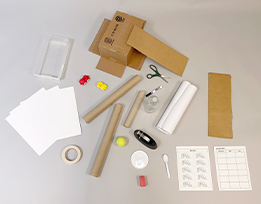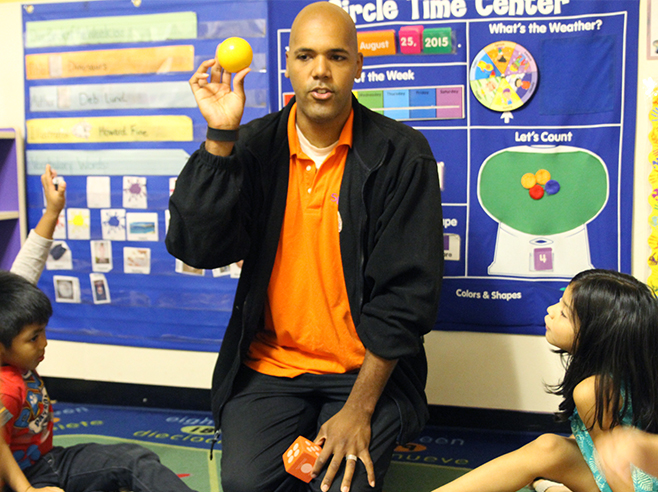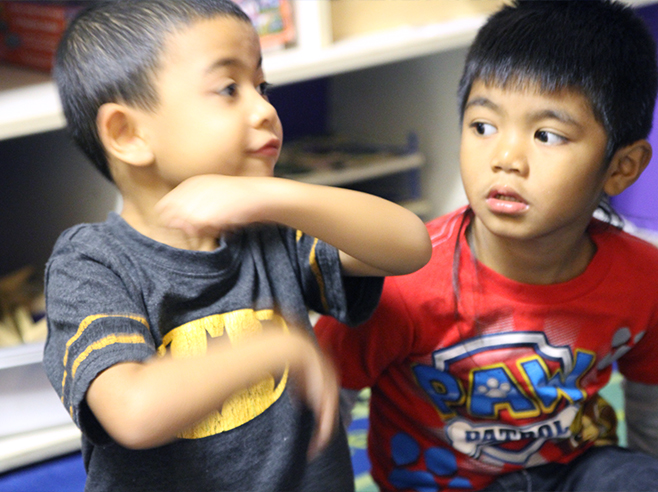Children choose objects and predict whether they will roll or slide down a ramp. They record their choices on a chart and then compare the results.
Materials

- Cardboard or wooden blocks or other item to prop up ramps
- Chart paper
- Crayon or marker
- Ramp materials (such as cardboard wrapping paper or mailing tubes, flat pieces of cardboard, poster board sheets)
- Sliding and rolling objects (such as a ball, a block, an empty juice box, a plastic container, a toy car, a yogurt lid, a spoon, an empty water bottle)
- Roll or Slide Chart Template (PDF)
- Roll Labels (PDF)
- Slide Labels (PDF)
- Tape (for taping labels to chart)
- Scissors
Preparation
- Cut cardboard tubes in half lengthwise to make troughs. Use the ramp materials to create and set up a ramp in the Circle time area. Put rolling and sliding objects in a pile near the ramp.
- Create a large Roll or Slide chart on chart paper. (See the Roll or Slide Chart template.) Write each child’s name in the first column. Leave the left-hand column blank.
- Make copies of the Roll and Slide labels and cut them apart. Put the tape and the labels near the chart.
Directions: Lesson 3
Guided Small Group
- Review how some objects roll and other objects slide. Tell children they will choose an object and then predict how the object will move down a ramp.
- Each child takes a turn choosing an object from a pile of rolling and sliding objects. Have them describe the object’s features (e.g., round, flat) and how they think it will move down the ramp. Possible discussion ideas:
- Why do you predict the (object) will (roll/slide)?
- Is there something about the shape of the (object) that makes you think it will (roll/slide)? Describe what you observe.
- Children take turns sending their objects down the ramp to check their predictions. After sending an object down the ramp, have each child tape a “roll” or “slide” label next to their name in the appropriate column on the chart.
- If a child predicts inaccurately, such as predicting a (block will roll), point out another object (juice box) that will slide like the (block). Ask children to describe what is similar about the (block and juice box). How is your (block) similar to the (juice box)? How is it different from the (ball)?
- Let’s try it again. How did your object move?
- Repeat the steps for each child in the small group. If all children do not get a chance to do the activity in Guided Small Group time, ensure that they will have a turn in Circle Time: Wrap-Up.
Circle Time: Wrap-Up
- Invite children who did not have a chance to choose and record an object in the Guided Small Group time to take a turn now. Each child chooses an object and predicts if it will “roll” or “slide” down the ramp. Then they send the object down the ramp and tape a label on the chart.
- After all children have recorded their results on the chart, have them compare the number of rolls and slides.
- Have children roll their arms if they think there are more “rolls” on the chart. Have them slide their hands back and forth if they think there are more “slides.”
- Together count how many “rolls” and how many “slides.”
- Have children count the number of labels in the “roll” column. Write the number at the bottom of the “roll” column. Repeat for the “slide” column.
- Discuss the results together. Possible discussion ideas:
- Did more objects roll or slide? Together, count how many objects roll. Then count how many slide.
- Why did the (ball) roll and not slide?
- What is different about the shape of objects that roll and those that slide?
- Did an object surprise you in the way it moved? How?


